De DVS is aanwezig bij het International Viola Congress 2016 in Cremona. Hier brengen DVS-bestuursleden Kristofer Skaug en Karin Dolman dagelijks verslag.
Jump to English Translation below.
Woensdag 5 oktober 2016
De dag begon met een herderlijk zonnetje, dus weer zomerkleren aan en op pad naar onze hoofdlocatie tussen Piazza Duomo en Piazza Stradivari, voor het eerste recital van de dag: “Argentina!” – zo luidde de titel van het programma. Het eerste stuk was Fantasia Tanguera No.8. door Ezequiel Diz (1977) voor altviool en piano. De componist laat horen dat hij argentijns tangobloed heeft. Goed geluisterd naar Piazzolla met levendige percussieve effecten, en de opbouw ook hetzelfde met een A, B en C gedeelte, waarvan het B-gedeelte (Andantino) ingeleid wordt door een cadenza en een prachtige sfeer neerzet. Dit allemaal vertolkt door Silvina Alvarez op altviool en Alicia Belleville op piano.
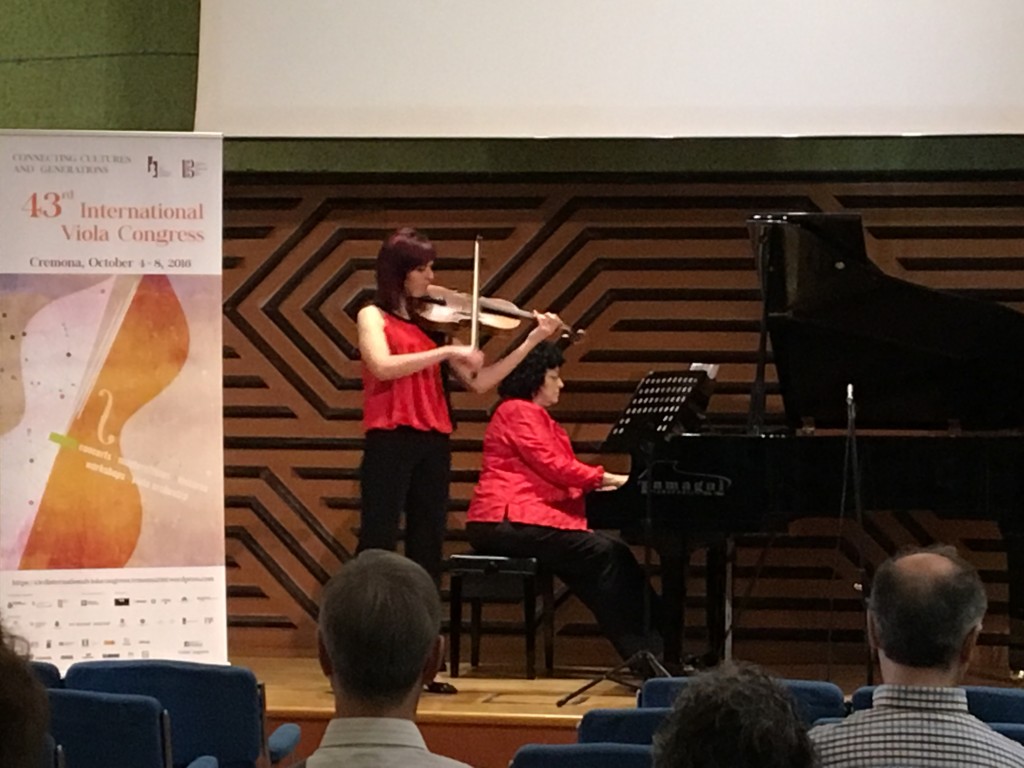
Het tweede stuk was van Jorge Variego (1975) voor twee altviolen en elektronica; er werd gebruik gemaakt van echo’s van de twee altviolen live via de microfoons en geluiden op tape. Echt knap gedaan door de altviolistes Daphne Gerling en Wendy RIchman, die speelden van tablets, voetpedaal om om te slaan en zelfs een mobiel erbij (voor de timer?).
Achter de knoppen zat de componist zelf. Opeens was er ook live computergrafiek bij, maar de muziek was druk en interessant genoeg.
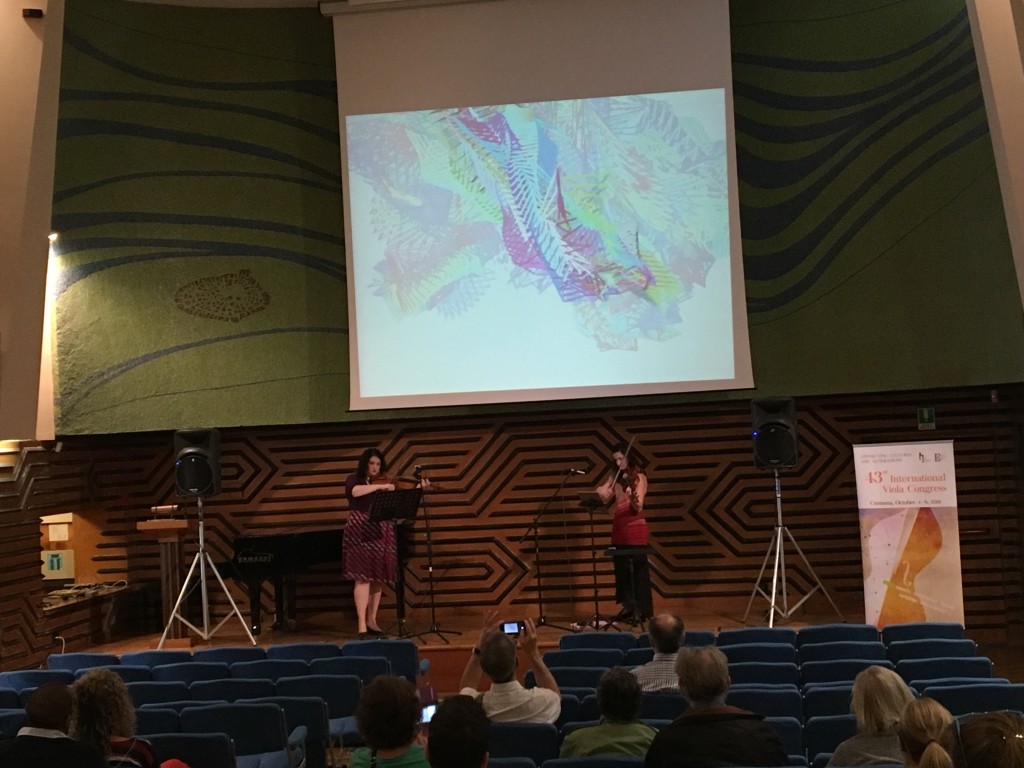
Daarna toog het congresvolk naar Museo del Violino, voor een recital met Tabea Zimmermann en haar studenten uit Berlijn. Vreemd genoeg zat dit concert niet inbegrepen in het passepartout van het Congres. Daardoor onstond grote vertraging bij de kaartverkoop. Toen we eenmaal binnen waren was alle frustratie echter snel vervlogen, want wat een prachtige concertzaal! Je waant je in het binnenste van een abstracte viool met elegante krommingen, en alles oogt naar gepolijst hout. De zaal is bovendien onder het maaiveld ingegraven, waardoor je het gevoel hebt af te dalen naar een geheime ondergrondse kamer waar iets wonderbaarlijks staat te gebeuren.
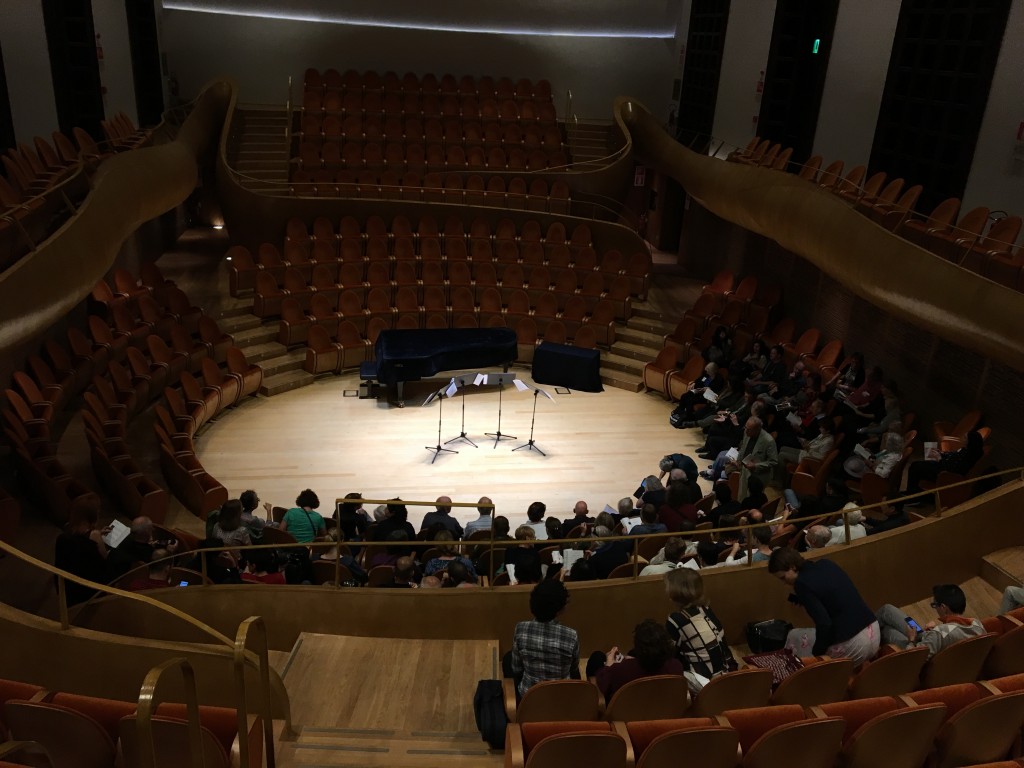
En dat gebeurde ook: Voorzover je kunt spreken van klassiekers als het gaat om repertoire voor altvioolkwartet, werden dezen wel allemaal gebracht: De mooie Fantasy Quartet van York Bowen, het Nachtstück van Von Weinzierl en de Marin Marais Variations van Garth Knox. Daartussen ook nog twee van de meest geliefde stukken voor altvioolduo: “Viola, Viola” van George Benjamin en het Lament van Frank Bridge. Alle uitvoeringen waren van zeldzame klasse!
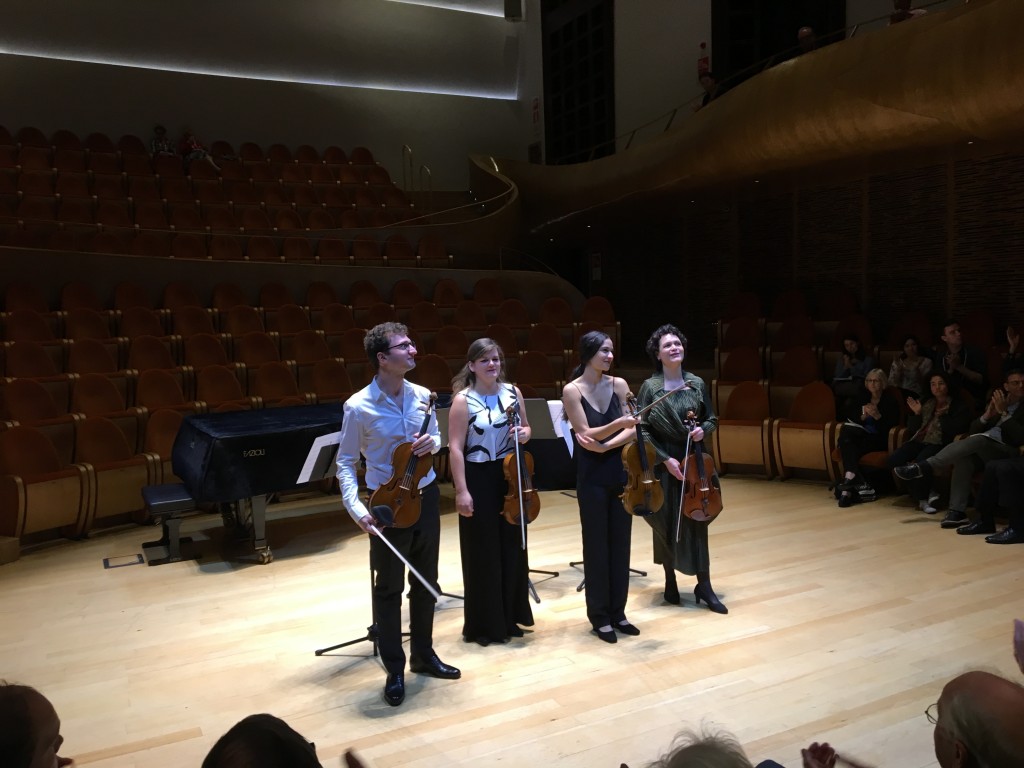
Dupe van de grote vertraging in het museum waren vooral Anna Serova en Jutta Puchhammer, wiens interessante en mooie lezingen-recitals na (te) lang wachten voor bijna lege zalen gespeeld werden.

Jutta Puchhammer is al jaren bezig met het opzoeken van alle opdrachtscomposities die speciaal zijn geschreven voor de eindexamens van het conservatorium van Parijs, de “Pièces de concours“. Hierover heeft ze ook vorig jaar bij haar bezoek in Dordrecht verteld. Deze stukken waren allemaal gebonden aan regels: Het moest toonladders en arpeggios bevatten, verschillende streektechtnieken, harmonische ontwikkelingen, snelle en gedragen passages. De periode van deze manier van werken ging van 1896 tot 1938. Een noemenswaardigheid is hierbij het ontstaan van de eerste echte altvioolklas.
Jutta Puchhammer speelde zelf samen met pianiste Elise Désjardins drie van deze pièces de concours, waarvan ook een CD met de eerste 18 stukken uitgegeven is, en ook de eerste volume van de bladmuziek (uitgever: Schott).
Tegelijkertijd vond de lezing-recital van Anna Serova plaats, die ging o.a. over de altvioolsonate van Sjostakovitsj. Jammer dat we deze moesten missen! Niet alleen vanwege de lezing van Puchhammer, maar ook omdat in datzelfde uurtje ook het eerste straatconcert van de nederlandse studenten plaatsvond: Op het plein voor het museum, in stralende zon en nèt iets te veel wind, helaas. Daardoor werd letterlijk een gat geblazen in o.a. het mooie Beethoven sextet (bew. door ondergetekende voor 4 altviolen).
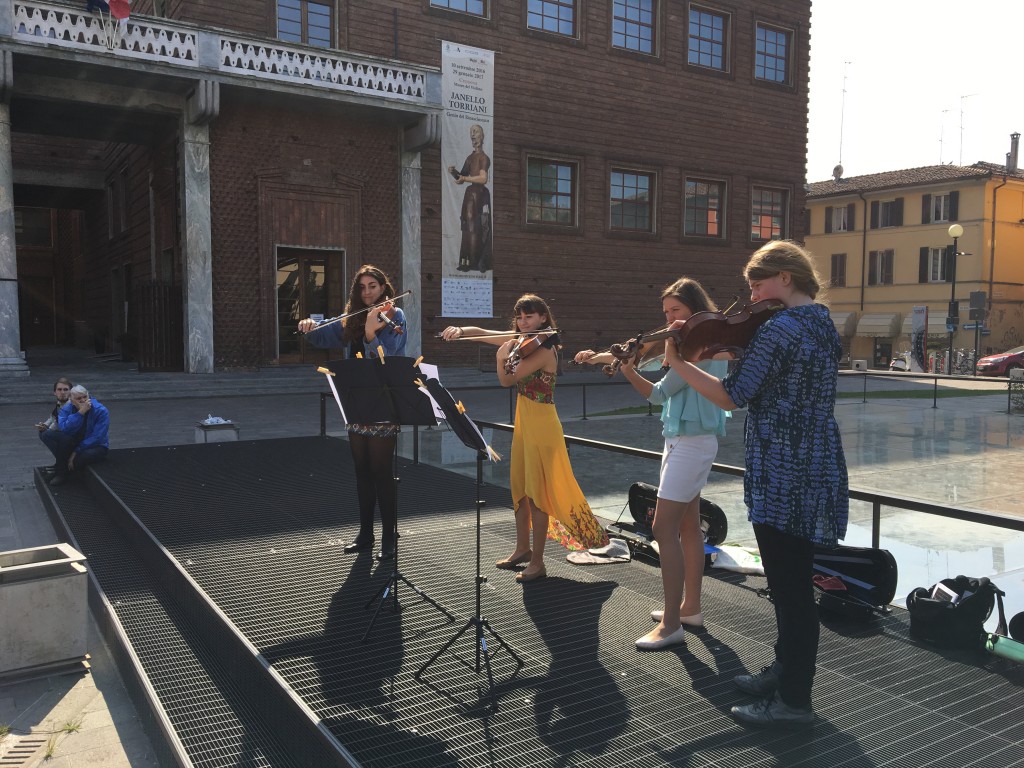 Tussendoor was er ook nog een repetitie van het altvioolorkest, met oog op het slotconcert van zaterdagmiddag. Maestro Fiore had muziek van Telemann, Mendelssohn, Verdi e.a.. bewerkt en dirigeerde het geheel ook zelf. Fijn om zelf eens te mogen spelen nadat mijn oren de laatste 30 uur volcontinu de klanken van anderen hebben opgezogen.
Tussendoor was er ook nog een repetitie van het altvioolorkest, met oog op het slotconcert van zaterdagmiddag. Maestro Fiore had muziek van Telemann, Mendelssohn, Verdi e.a.. bewerkt en dirigeerde het geheel ook zelf. Fijn om zelf eens te mogen spelen nadat mijn oren de laatste 30 uur volcontinu de klanken van anderen hebben opgezogen.
Om 15.00 uur waren er weer twee lezingen tegelijk. Wij kozen voor de lezing van Susanne Schaal-Gotthardt, musicologe en werkzaam bij het Hindemith instituut in Frankfurt. Een mooi pleidooi voor het altviool-oeuvre van Paul Hindemith, vooral met een beetje tijdsbeeld achtergrond. Het jaar 1919 is zo’n voorbeeld, hij kwam net terug van het het gruwelijke oorlogsfront in de Elzas en Vlaanderen. Dit was wel het jaar waar Hindemith voorgoed voor de altviool koos en alleen in geval van nood de viool pakte. Hij schreef dat jaar twee sonates voor de altviool, één met piano en één solowerk. Zijn meest gespeelde werken, niet alleen door hemzelf, maar ook nu nog. En zo volgden vele voorbeelden. Kortom een lezing om nog eens te houden of zelf een boek over zijn leven te lezen.
Karin koos vervolgens voor een lezing over de Stauffer Academy in Cremona. Een opleidingsinstituut voor strijkers, vioolbouw en Musicologie. De opleiding voor strijkers is een betaalde opleiding door het instituut. Bruno Giuranna heeft een altvioolklas van 12 studenten die eens per maand voor 3 dagen naar Cremona komen voor les.
Geen examens, alleen gericht op vooruitgang. En soms heeft dat tijd nodig.
In de parallelle sessie gaf Luca Sanzò, hoofdvakdocent uit Rome, een recital met als thema 20e eeuwse muziek voor altviool en viola d’amore. Het stuk “Studi profondi” van Lucia Ronchetti (1963) bevatte een opmerkelijk deel dat voortborduurde op het treurmarsj uit het pianokwintet van Schumann, in steeds meer atonale variaties. Professore Sanzò pakte de viola d’amore op in het stuk “Solo” van Georg Friedrich Haas (1953), dat heel goed liet horen hoe anders zo’n instrument is. Daarin zat ook de “trick play of the day“, een rechterhands-pizz tussen stok en kam, terwijl tijdelijk werd doorgestreken met de linkerarm! Tot besluit een geslaagde renditie van het welbekende op. 25 no.1 van Hindemith (op gewone alt). Mooie toon, en soms onorthodoxe keuzes in tempo en frasering waardoor je op het puntje van de stoel bleef zitten.

Ook na dit recital bleef ik op mijn stoel zitten, want daar kwam Michael Kugel binnenlopen voor een masterclass. Twee studenten uit Birmingham hadden zich hiervoor opgegeven. De ene speelde het “Allegro molto appassionato” van Frank Bridge, en miste aanvankelijk beide voornemens van de componist. Na enig inpraten van de maestro lukte het wel om een best vurige vibrato op te wekken, op zich geen slecht rendement voor een klein halfuurtje. Door naar de volgende student, die een stuk van Reger heel muzikaal vertolkte. Hier hield Kugel een uitgebreid verhaal over muzikale taal en grammatica. Er werd geoefend op frasering.
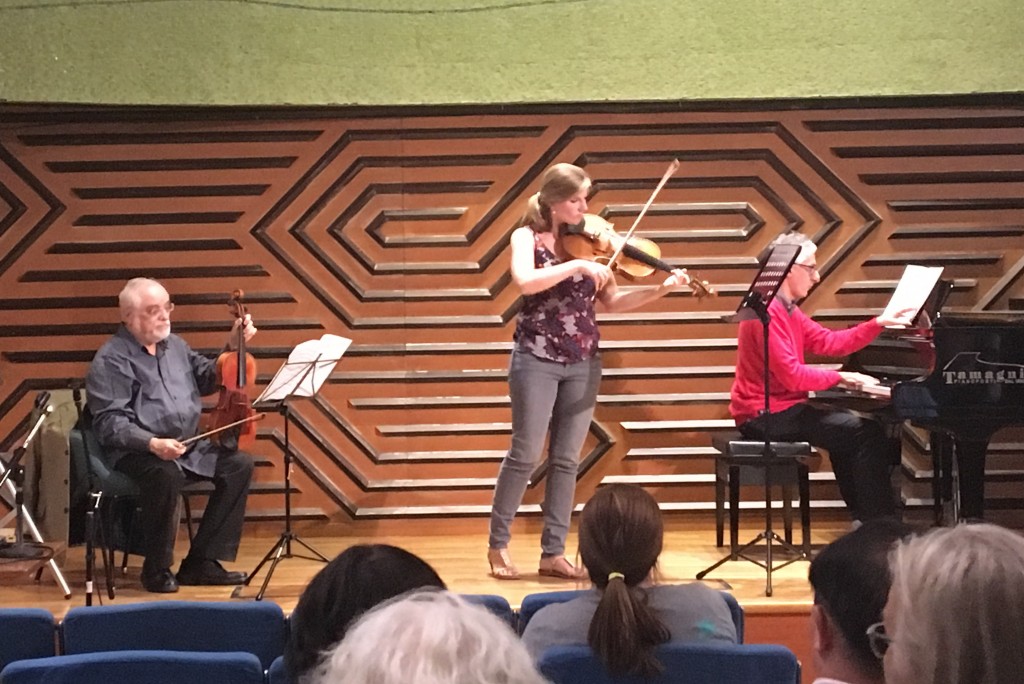
Het avondconcert was weer in het mooie auditorium van het vioolmuseum (waar we vanochtend naar Tabea luisterden). Vanochtend was het nog zonnig en warm, maar nu was het weer plotseling omgeslagen en regende het huisdieren (gisteren was nog dierendag…). Koud was het ook.
Muzikale gastheer van deze avond was niemand minder dan Bruno Giuranna. Het was tijd voor Brahms, heel veel Brahms: Zijn beide strijkkwintetten, om precies te zijn. Hiervoor had hij een viertal goede jonge musici bij elkaar gebracht, waaronder Maria Kropotkina, die onlangs in Maastricht bij Kugel is afgestudeerd en sinds september bij Mikhail Zemtsov zit in Den Haag. Tussendoor gaat ze naar voornoemde Stauffer Academy in Cremona om bijles te krijgen bij Giuranna. .
Wat te zeggen over twee Brahmskwintetten op één avond: Karin en ik verschilden van mening. Karin vond het vooral fijn om eens een avond helemaal in de warme klanken van Brahms gedompeld te worden. Er werd met verve gemusiceerd, en dan merk je je vermoeidheid niet meer. Ik vind Brahms natuurlijk ook fijn, maar zijn kwintetten vind ik elk op zichzelf al zware kost, en achter elkaar geplaatst wordt het een marathon. Zo zie je volgens mij ook nooit zijn beide sextetten samen op één avond. En dan nog laat beginnen en doorspelen zonder pauze. Het is indrukwekkend Giuranna dat nog volhoudt, met zijn 83 jaar. Wie ben ik dan, een ruime generatie jonger, om te klagen over vermoeidheid?
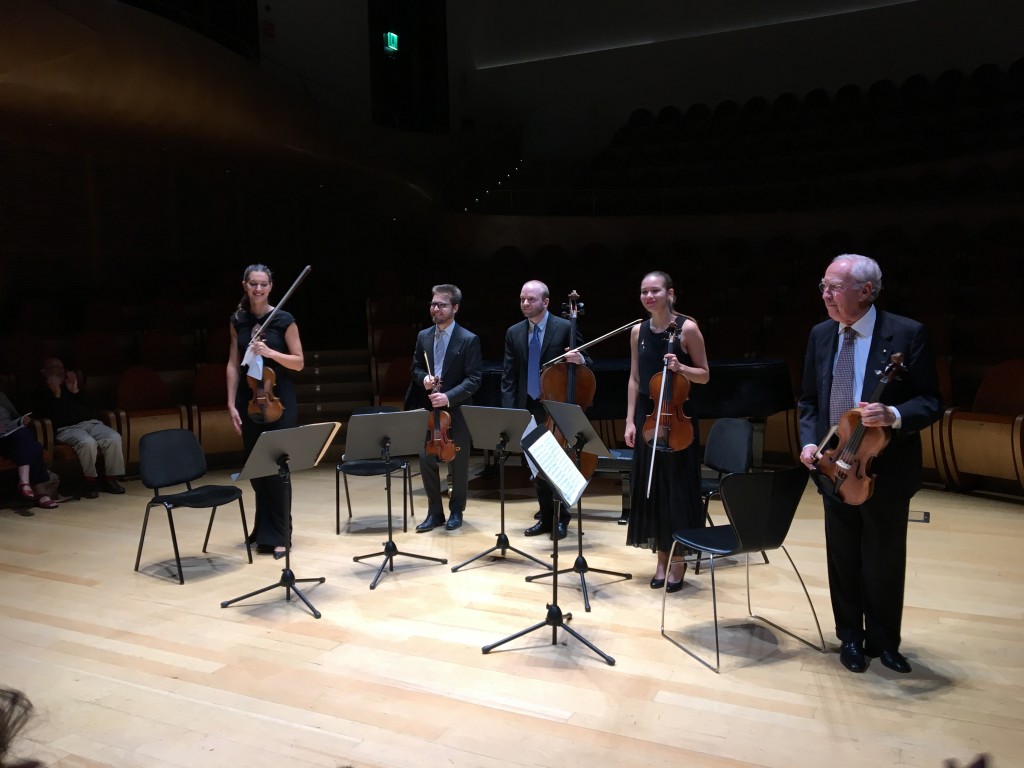
Highlights voor morgen:
Ettore Causa recital, een lezing/recital van Giuranna en natuurlijk morgenavond met orkest de finale van het concours.
Karin Dolman en Kristofer Skaug
Wednesday, October 5th 2016
The day started out sunny and warm, so with summer clothes on we make our way to the main congress locatino between Piazza Duomo and Piazza Stradivari. The first recital of the day: “Argentina!” The first piece was Fantasia Tanguera No.8. by Ezequiel Diz (1977) for viola and piano. The composer shows that he has Argentine tango blood. He has listened carefully to Piazzolla, with lively percussive effects and an A-B-C structure, in which the B-part (Andantino), introduced by a cadenza, portrays a wonderful atmosphere. This was performed by Silvina Alvarez (viola) and Alicia Belleville (piano).
The second piece was by Jorge Variego (1975), for two violas and electronics; use was made of echoes of the two violas, live through the microphone and sounds on tape. Very well done by the violists Daphne Gerling and Wendy RIchman, who played from tablets (using a pedal to turn pages) and even a mobile phone (for the timer?). The composer himself managed the electronics. There was also some live computer graphics involved, but that seemed to distract from the music, which was interesting enough in itself.
After this, the Congress crowd set off to the Museo del Violino for a recital by Tabea Zimmermann and her students from Berlin. Oddly enough, this concert was not included in the congress fee, so a big delay was incurred in the ticket office. But once inside, we quickly forgot this frustration: what a beautiful concert hall! You find yourself inside an abstracted violin with elegant curves, and all surfaces are shiny polished wood. The hall is built somewhat below ground level, so you get the feeling that you are descending into a secret underground chamber where miraculous things are about to transpire.
And so they did: Insofar as one can speak of “classics” in the context of repertoire for viola quartet, this programme had them all: The beautiful Fantasy Quartet by York Bowen, the Nachtstück by Von Weinzierl and the Marin Marais Variations by Garth Knox. In between we also got two of the most popular pieces for viola duo: “Viola, Viola” by George Benjamin and the Lament by Frank Bridge. All performances were of exceptional quality!
The big delay at the museum sadly impacted the lecture-recitals of Anna Serova and Jutta Puchhammer, which could only start after a (too) long wait, and in the end did not get the audience size they deserved.
Jutta Puchhammer has been busy for some time with the research on the “Pièces de concours“, written for the final exams at the conservatory in Paris. These pieces had to conform to various rules: They must have scales and arpeggios in them, different bowing techniques, harmonic developments, fast and calm passages. The era of this way of working laster from 1896 to 1938. Mentionable fact is the origin of the first-ever true viola class in this context. Jutta Pucchhammer played three of these pieces herself, with pianist Elise Désjardins. The first 18 pieces have been recorded on CD, and the first volume of the sheet music has been published (Schott).
In parallel with this, Anna Serova’s lecture-recital treated the Shostakovich viola sonata. It’s a pity that we had to miss this! Not only because of the Puchhammer lecture, but also due to the fact that the Dutch students were giving their first street concert in that same time slot, on the square in front of the museum. The weather was still warm and sunny, but there was also just a bit too much wind at times. Music stands kept falling over.
We also rehearsed with the viola orchestra, for the final concert on Saturday afternoon. Maestro Fiore had arranged music by Telemann, Mendelssohn, Verdi and others, and he conducted it himself. It was nice to play something myself for a change, after having continuously absorbed the sounds of others for the past 30 hours.
At 3 p.m. once again there were two simultaneous events. We chose the lecture by Susanne Schaal-Gotthardt, musicologist working at teh Hindemith Institute in Frankfurt. She advocated the viola oeuvre of Hindemith, giving also historical background information. In 1919 for example, he had just returned from the horrors of the front in Elzas and Flanders. This was the year that Hindemith definitively chose the viola as his instrument. He wrote two viola sonatas that year, and these both remain his most-played viola works to this day. More great examples were given, this lecture could well bear repeating.
Karin next chose a lecture about the Stauffer Academy in Cremona: An institute of education for string players, luthiers and musicologists. The string students receive a scholarship from the Institute. Bruno Giuranna’s viola class there counts 12 students who come to Cremona once per month for lessons. No exams, just aiming at progress, even if that sometimes takes more time.
The parallel session was hosted by Luca Sanzò, viola professor from Rome. His recital focused on 20th century music for viola and viola d’amore. The piece “Studi profondi” by Lucia Ronchetti (1963) included a remarkable movement which elaborated on the funereal march from Schumann’s piano quintet, with ever increasing atonality. Prof. Sanzò picked up his viola d’amore for the piece “Solo” by Georg Friedrich Haas (1953), which very effectively illustrated how different this instrument is. In this piece we also were witness to the “trick play of the day“, a right-hand-pizz between the bow and the bridge, while the left hand / arm was temporarily taking over the bowing! The programme wrapped up with a very good rendition of Hindemith’s well-known op. 25 no.1 (with a regular viola). Nice quality of tone (except in the 4th mvt, as expected). Some unorthodox choices in tempo and phrasing kept us hanging on the edge of our seats.
Even after this recital I decided to stay in my seat, because along came Michael Kugel for a masterclass. Two students from Birmingham had been selected for this. The first student played “Allegro molto appassionato” by Frank Bridge, but initially failed to accomplish either of the composer’s written intentions. After some mental coaching by Kugel, the student succeeded in the production of a fiery vibrato. The next student played some Reger, very musical. This was nevertheless reason for Kugel to deliver a speech about musical language and grammar. Phrasing questions were examined further.
The evening concert was again in the beautiful auditorium of the Violin Museum (where we listened to Tabea this morning). The weather had suddenly changed, it was raining domestic animals, and it also became quite chilly.
Our musical host this evening was Bruno Giuranna himself. And it was time for Brahms, a lot of Brahms. Both of his string quintets, to be exact. For this purpose, Giuranna had brought to gether a foursome of excellent young musiciants – among them Maria Kropotkina, who recently graduated in Maastricht with Kugel, and currently studies with Mikhail Zemtsov in The Hague. She also attends the above-mentioned Stauffer Academy in Cremona, for extra lessons with Giuranna. .
But what should we say about two Brahms quintets in one evening? Karin and I held different opinions about this. In Karin’s view, it was good to be able to submerge in warm Brahms for a whole evening. She found that the musicians’ energetic performance helped forget one’s own fatigue.
I like Brahms as much as the next guy (and probably a lot more!), but I think his string quintets are quite heavy each by themselves. Same with his famous sextets, they are rarely ever performed back-to-back. Add to this a late starting time and the absence of a proper intermission … it is in fact impressive that Giuranna himself keeps this up, being 83 years of age. So who are we, to complain of tiredness?
Highlights for tomorrow:
A recital by Ettore Causa, a lecture-recital by Giuranna, and of course the competition final tomorrow night!
Karin Dolman and Kristofer Skaug
